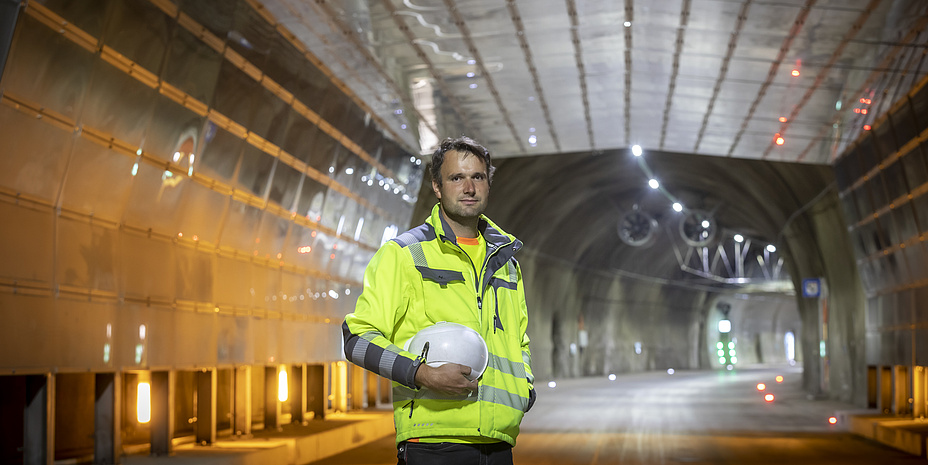“A Tunnel Is Not a Health Resort”

News+Stories: Let’s get something out of the way: can I take a deep breath in a tunnel with a clear conscience?
Daniel Fruhwirt: Yes, the air quality in a tunnel meets the requirements for deep breathing. Nevertheless, a tunnel is of course not a health resort. As with almost all pollutants, the dose makes the poison. Long-term effects also occur with continual inhalation of pollutant-rich air. We know this from urban areas, where the air quality is poor and life expectancy is lower than in other regions.
And tunnels have ventilation systems. Why exactly are they needed?
Fruhwirt: First, it’s about maintaining sufficient air quality to enable the lowest possible pollution and also for the best possible visibility. Secondly, with the ventilation system we can influence the spread of smoke in the tunnel in the event of a fire and thus create the most favourable escape conditions possible.
So if there’s a fire in the tunnel, the smoke is specifically blown away from the escape areas?
Fruhwirt: Yes. A fire produces large quantities of flue gases. Their effect can be toxic or they inhibit oxygen uptake via the lungs. If humans are exposed to these gases for too long or in concentrations that are too high, it is impossible for them to escape. So safe, smoke-free or at least low-smoke areas are needed in the tunnel. We achieve this via so-called smoke management by means of mechanical ventilation systems.
What pollutants are produced in a tunnel? And how dangerous are they for humans?
Fruhwirt: The pollutants are not only produced in the tunnel, but in general through traffic, in other words through the combustion of diesel or petrol. Primarily CO2 and nitrogen oxides (NOx) are produced, but also numerous by-products such as carbon monoxide (CO). Due to strict regulation of combustion emissions, nowadays non-exhaust emission become more and more relevant. These non-exhaust emissions include rubber abrasion, i.e. microplastics, heavy metals, but also so-called volatile organic compounds or gaseous substances due to evaporation processes. Since the pollutants in the tunnel are generally sufficiently diluted, there is no immediate danger to health and life. A permanent monitoring process of in-tunnel air quality ensures a safe passage of the tunnel.
Why is the air in the tunnel so much worse than outside?
Fruhwirt: Because the pollutants are much less diluted in tunnels, so that generally higher pollutant concentrations occur than on surface roads. If the concentrations exceed the limit values, either the ventilation rate must be increased, by activating additional fans, or in extreme cases the tunnel must be temporarily closed. This problem was much more pronounced in the past, as the vehicle emission standards now in force have reduced the emissions of vehicle fleets considerably. Nevertheless, especially in long road tunnels that are operated in two-way traffic, that is, where traffic flows in both directions in one tunnel tube, unacceptable concentrations of pollutants can still occur depending on the volume of traffic.
How does fresh air get into a tunnel? And how are pollutants removed?
Fruhwirt: On the one hand, the vehicles already bring fresh air into tunnels through their so called piston effect. Here, we talk about traffic-induced air flow. Often, however, the amount of fresh air brought in must be increased by mechanical ventilation systems. This air flow dilutes and eventually “removes” the pollutants. A distinction is made here between supply air systems – where fresh air is brought in, and exhaust air systems – where exhaust air is extracted. In the end, both systems have the same goal, namely good air quality and the creation of safe areas.
What is the function of the large fans on the tunnel ceiling?
Fruhwirt: The fans on the tunnel ceiling convert electrical energy into "flow energy". The air drawn in by these jet fans is massively accelerated. As a result, the momentum of this exit flow also sets the remaining air in the tunnel in motion. The so created air flow dilutes the pollutants inside the tunnel and expels smoke in case of a fire.
What happens to the air in the tunnel when a traffic jam occurs?
Fruhwirt: In congested situations, a relatively large number of vehicles are in a tunnel at the same time. This increases the emission of pollutants. This means that the demand for fresh air will also increase and the tunnel ventilation will most likely have to be activated or its capacity increased.
Where in the tunnel is the air the worst?
Fruhwirt: This depends strongly on the tunnel geometry and the existing ventilation system. In the case of classic longitudinal ventilation with jet fans, the highest pollutant concentration is at the exit portal. In so-called transverse ventilation systems, the location is influence by multiple parameters and might be somewhere in the tunnel. However, due to the permanent monitoring of the in-tunnel air quality, a safe passage through the tunnel is granted.
Tunnel air is basically breathable. When passing through the tunnel for a short time, apart from the perhaps unpleasant smell of the exhaust fumes, no significant adverse effects are to be expected. To avoid the smell, simply switch the vehicle ventilation system to recirculation for the duration of the drive-through.
What is the best way to protect myself in the car from bad air in the tunnel?
Fruhwirt: As I said, the tunnel air is basically breathable. When passing through the tunnel for a short time, apart from the perhaps unpleasant smell of the exhaust fumes, no significant adverse effects are to be expected. To avoid the smell, simply switch the vehicle ventilation system to recirculation for the duration of the drive-through. However, in urban areas, driving in traffic also leads to increased exposure to traffic-related pollutants.
How does the tunnel structure itself withstand the air pollutants?
Fruhwirt: Pollutants have more or less no effect on the tunnel structure. Nevertheless, tunnels are cleaned regularly to remove dust adhering to tunnel walls and installations, for example lights.
The safety level of the tunnels in Austria is certainly one of the highest in the world, also in terms of air quality.
We now have pretty good tunnel systems in Austria. Are tunnels around the world as well ventilated as here?
Fruhwirt: Different strategies exist worldwide with regard to the ventilation of tunnel systems. However, the goal of sufficiently good air quality in tunnels exists everywhere. In Europe, there are minimum requirements for the ventilation of tunnels, which were laid down in an EU directive in 2004. All countries in the EU are obliged to comply with these specifications, so it can generally be assumed that tunnel systems in the EU with a length of 1000 metres or more have a suitable ventilation system. The safety level of the tunnels in Austria is certainly one of the highest in the world, also in terms of air quality.
What about underground garages? Are they similar to tunnels?
Fruhwirt: Underground garages are a different matter. Many are naturally vented, i.e. without mechanical ventilation. And if mechanical ventilation is available, it is significantly less powerful than in tunnel systems. But sensors are also installed in underground garages to detect unacceptable concentrations of pollutants. Carbon monoxide alarms are one example.
We have ongoing research projects to evaluate safety-critical issues related to fuel cell vehicles that operate on hydrogen.
What are you working on in terms of air in tunnels?
Fruhwirt: In the Transport & Environment working group at the Institute of Thermodynamics and Sustainable Propulsion Systems, we are currently looking on the influence of vehicles with new energy carriers on tunnel safety. We have ongoing research projects to evaluate safety-relevant issues related to fuel cell vehicles that operate on hydrogen, or on the topic of toxic gases in fires involving battery-electric vehicles in tunnels (press release: Fire Tests Show that Austria's Tunnels are Fit for Electric Cars). Among other things, this is also to be done within the Unite! network, of which TU Graz is now a member.
This article is part of the TU Graz dossier "Pollutants in the air". Would you like to receive the latest stories, research stories, interviews or blog posts from TU Graz directly on your smartphone or in your email inbox? Subscribe to the TU Graz Telegram newsletter for free.
Kontakt
Daniel FRUHWIRT
Dipl.-Ing. Dr.techn. BSc
Institute of Thermodynamics and Sustainable Propulsion Systems
Research Area Traffic and Environment
Phone: +43 316 873 30191
fruhwirt@tugraz.at




